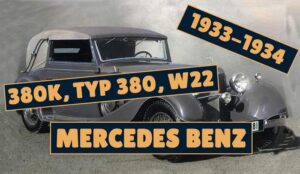The long history of the automobile industry is ingrained in the principle of evolution. There is always a need for a better design and improved functions, which propelled the Industry forward, and it was on this principle that the Mercedes-Benz W 11 was birthed.
If you want to know more about this classic vehicle, you’re in the right place as I will be telling you all about it.
Mercedes-Benz W11 – Overview
The Mercedes-Benz W11 was an average six-cylinder car launched by Daimler-Benz in 1929. It was designed from its precursor, the Mercedes-Benz W02, in 1926, and while the W11 shared its structure and framework with the W02, the W11 was produced with a bigger, more powerful engine, a new name, and a broader list of standard body types from which customers could choose.
The model was basically introduced as an improvement to the Stuttgart 200, with which it shared the same characteristics and design but was fitted with a larger engine displacement of 2.6 L, and though no significant changes had been made, there was a significant increase in power to 50 hp.
This vehicle was also known as the Mercedes-Benz 10/50 PS and Mercedes-Benz Stuttgart 260. It remained in production until the beginning of 1934.
Mercedes-Benz W11 – Naming History
Like many other vehicles of this generation, the producers followed the popular German naming system, hence the name Mercedes-Benz 10/50 PS with the 10 specifying the car’s tax horsepower and the 50 describing the actual power output in horsepower.
To tackle reoccurring name issues with other vehicles produced by Mercedes, the name Stuttgart as well as Mercedes-Benz W11 was adopted.
Mercedes-Benz W11 – Development
The car was sold in a bare chassis form to individuals seeking to buy a car body from an individual coach builder. Standard manufacturers’ bodies available then included a Torpedo-bodied Tourenwagen and a 2 or 4-door Limousine body. A range of three separate Mercedes-Benz cabriolet bodies was referred to as Cabriolet A, Cabriolet C, and Cabriolet D.
The side-valve 6 cylinder 2.581 cc engine produced a maximum output of 50 hp at 3 400 rpm, which resulted in a top speed of 90 km/h (56 mph).
Power transmission to the rear wheels was through a four-speed manual transmission system. The wheels were attached to a rigid axle, which was suspended from the semi-elliptical leaf springs, and the braking, which was applied to all four wheels, was mechanically operated by means of rod connections.
The Mercedes-Benz W 11 laid the foundation for the L 1,000 Express. This model shared the technical characteristics of the Mercedes-Benz W11 and was known as the W37, which was designed for commercial users, and mostly sold as a delivery van, an ambulance, or as a 10 seater minibus.
Mercedes-Benz W11 – Production
The 10/50 PS/Typ Stuttgart 260 and the less efficient but pretty similar Typ Stuttgart 200 were the Mercedes-Benz series’ mainstays between 1929 and 1932. 5640 cars that were manufactured in 1929 accounted for 66% of the company’s output. The corresponding figures for 1930, 1931 and 1932 are 4453, 2320 and 885 cars respectively.
1934 marked the end of the production of Mercedes-Benz W11, of which 6807 had been manufactured, achieving considerable success in the market. I’m sure we can agree it was a good way to end a great tale.
Mercedes-Benz W11 – Price Range
The Mercedes Benz W11 can be acquired nowadays for as high as $200,000 in various auctions around the globe.
That’s all folks, if you have enjoyed the article, it’ll be greatly appreciated if you smash the share button, and stay tuned for another classic car articles.

![You are currently viewing Mercedes-Benz W11 [Stuttgart 260, 10/50 PS] – (1929 – 1034)](https://classicsdude.com/wp-content/uploads/2021/05/Mercedes-Benz-W11-website.jpg)
![Read more about the article Mercedes 24/100/140 PS [Mercedes-Benz Typ 630] (1924 – 1929)](https://classicsdude.com/wp-content/uploads/2021/04/Hitlers-car-website-300x174.jpg)

![Read more about the article Mercedes-Benz S-Series [S/ SS/ SSK/ SSKL Models] (1927 – 1933)](https://classicsdude.com/wp-content/uploads/2021/05/series-S-website-300x174.jpg)